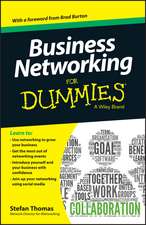Discretionary Managerial Behavior
Autor T.V.S. Ramamohan Rao, Ranjul Rastogien Limba Engleză Paperback – 8 oct 2012
Both theoretical and empirical literature of organizational economics have not come to grips with the decision making process in such organizations. With this in perspective the volume describes four fundamentally new contributions. It presents:
- an approach to defining proximate objectives of managers at the divisional levels in a decentralized organization and the coordination by managers at higher levels,
- an approach to developing a modelling framework from a sound theoretical perspective in order to reflect the postulated behavior,
- an approach to defining an estimation technique to operationalize both (a) and (b) in a specific empirical context, and
- the richness of empirical insights which remained elusive for over thirty years. As such this study is an important step to make fundamental progress in the area of interface between business policy and microeconomic theory.
| Toate formatele și edițiile | Preț | Express |
|---|---|---|
| Paperback (1) | 637.78 lei 43-57 zile | |
| Springer Us – 8 oct 2012 | 637.78 lei 43-57 zile | |
| Hardback (1) | 643.99 lei 43-57 zile | |
| Springer Us – 31 oct 1997 | 643.99 lei 43-57 zile |
Preț: 637.78 lei
Preț vechi: 750.33 lei
-15% Nou
Puncte Express: 957
Preț estimativ în valută:
122.04€ • 127.74$ • 101.58£
122.04€ • 127.74$ • 101.58£
Carte tipărită la comandă
Livrare economică 31 martie-14 aprilie
Preluare comenzi: 021 569.72.76
Specificații
ISBN-13: 9781461377825
ISBN-10: 146137782X
Pagini: 244
Ilustrații: XXI, 219 p.
Dimensiuni: 155 x 235 x 13 mm
Greutate: 0.35 kg
Ediția:1997
Editura: Springer Us
Colecția Springer
Locul publicării:New York, NY, United States
ISBN-10: 146137782X
Pagini: 244
Ilustrații: XXI, 219 p.
Dimensiuni: 155 x 235 x 13 mm
Greutate: 0.35 kg
Ediția:1997
Editura: Springer Us
Colecția Springer
Locul publicării:New York, NY, United States
Public țintă
ResearchCuprins
1. Sources of Managerial Discretion.- 1.1. Managerial Discretion.- 1.2. Market Share.- 1.3. Product Diversification.- 1.4. Organizational Structure.- 1.5. Corporate Control.- 1.6. Incentives and Monitoring.- 1.7. Nature of the Study.- 2. The Corporate Decision Process.- 2.1. The Milieu.- 2.2. The U-Form Organization.- 2.3. The M-Form Organization.- 2.4. The Major Lessons.- 2.5. Proximate Divisional Objectives.- 2.6. Need for Progress.- 3. Modelling Framework.- 3.1. The Issues.- 3.2. The Current Practice.- 3.3. The Correct Formulation.- 3.4. Some Practical Difficulties.- 4. Method of Estimation.- 4.1. The Problem.- 4.2. The Current Status.- 4.3. The Proposed Estimation Procedure.- 4.4. Further Generalization.- 4.5. Problems of Inference.- 5. Operationalizing the Model.- 5.1. The Data Base.- 5.2. Some Accounting Definitions.- 5.3. The Variables.- 5.4. Some Limitations.- 6. Investments and Capital Structure.- 6.1. The Strategic Choices.- 6.2. The Implicit Contract.- 6.3. The Constraints on the Management.- 6.4. Managerial Preferences.- 6.5. Expected Patterns.- 6.6. Empirical Experience.- 7. Selling Costs and Market Share.- 7.1. The Marketing Decision.- 7.2. The Model.- 7.3. The Results.- 8. Production Inventory Decisions.- 8.1. The Focus.- 8.2. Modelling Framework.- 8.3. Empirical Results.- 9. In Retrospect.- 9.1. The Theoretical Progress.- 9.2. Issues of Model Specification.- 9.3. Estimation Problems.- 9.4. Conclusion.- References.



















